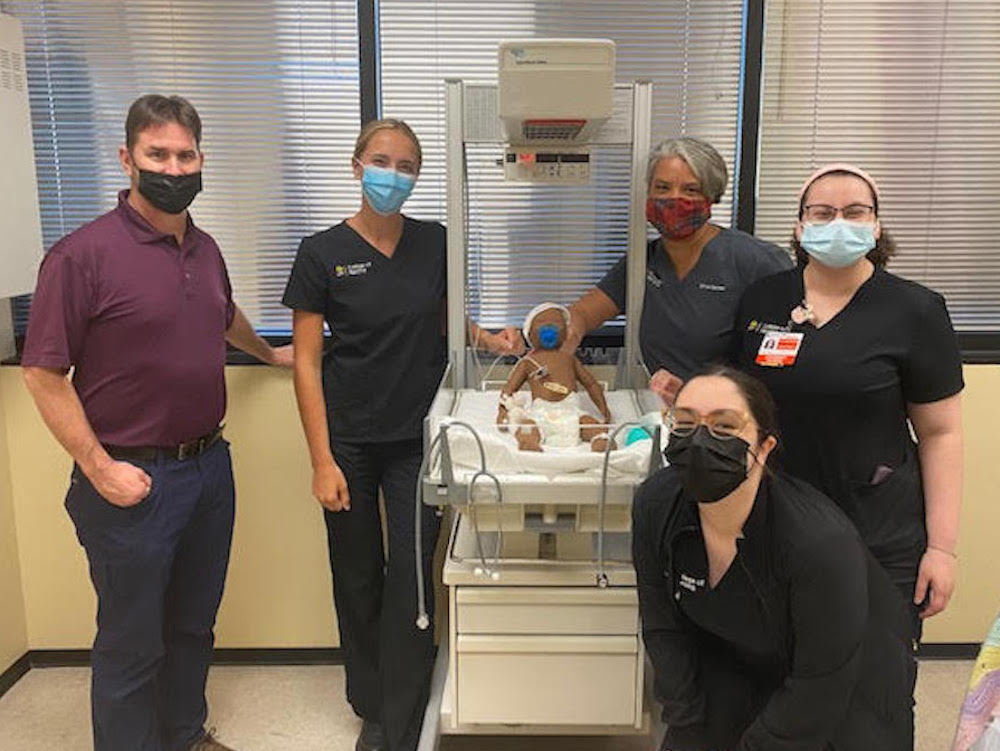University of Central Florida Addresses Minority Infant Mortality Through Inclusive Clinical Simulation
As the use of clinical simulation across healthcare education and training expands, many simulation centers and programs have increased efforts to promote diversity, equity and inclusion. This is important because, according to an article published on the National League for Nursing (NLN) Nursing EDge blog, “Exploring Newborn Health Disparities through Simulation,” infants of non-Hispanic Black women currently have the highest mortality rates in the United States. To help learners better train for these circumstances, nursing faculty and undergraduate pre-licensure students at the University of Central Florida developed a minority-focused clinical simulation.
The evidence-based simulation depicted a 12-hour-old infant of a Black mother with gestational diabetes. Written by Desiree Díaz, Ph.D., RN-BC, CNE, CHSE-A, ANEF, FAAN; Valerie Martinez, DNP, APRN, CPNP-PC; Andrew Todd, MLIS, BSN; Charlize Soto, BSN; Anna Cook, BSN; and Ilisha Strassler, BSN, the NLN article shared that infants born to mothers with gestational diabetes are at risk of being born large-for-gestational-age (LGA) with congenital anomalies and of developing hypoglycemia, hyperbilirubinemia and respiratory distress after birth. To address this risk, the UCF simulation explored caring for the infant with previous hypoglycemia who also had difficulty latching.
Learners who were participating in this clinical simulation scenario were required to recognize the need to perform a point-of-care blood glucose check on the infant and complete “a thorough assessment before returning the infant to the mother’s chest for breastfeeding.” Learners were also expected to educate the mother on bonding, breastfeeding, circumcision, hypoglycemia and sleep. Pre-simulation activities were selected based on gaps in knowledge for undergraduate nursing students related to the care of newborns, the article explained.
Sponsored Content:
The authors shared that this healthcare simulation provided learners with the opportunity to discuss and reflect on the many issues relating to race and ethnicity across medical settings. Further, after experiencing the clinical simulation, they were asked to share personal reflections related to the content and their feelings and emotions if comfortable sharing with the group. This debriefing occurred in a psychologically safe environment in which facilitators reminded learners that the content of the reflection and discussion could elicit personal memories and responses.
Prior to these discussions, all facilitators were reminded to review the Society for Simulation in Healthcare (SSH) Healthcare Simulationist Code of Ethics (2018) and INACSL Standards of Best Practice (2016) to learn about expected behaviors and to set the stage for deep discussion. Afterward, the authors reported that from these discussions, some learners experienced visceral responses to implicit bias and healthcare disparities. Having read recent literature on current national trends, relevant issues and evidence-based data before the simulation experience, the educators were prepared for potential dissonance.
From the experience, the authors shared that clinical simulation settings may be limited in their ability to alter or change the physical characteristics of a healthcare simulation manikin. Further, settings with access to lighter skin tone manikins may want to consider other options to incorporate diverse backgrounds into a scenario. The authors write: “One suggestion is to include family dynamics that may be encountered in the birth of a first born. Another option is to shift the culture of the patient. Changing the race or ethnicity of the mother and baby in the scenario provides an opportunity to explore culturally congruent care.”
Together, they concluded that healthcare simulation provides an opportunity for learners to practice care for marginalized populations in a safe environment. Their hope is that diverse clinical simulation scenarios aimed at newborn health disparities “will be a catalyst for improved patient outcomes.”
Sponsored Content:
“It was an honor to work with the student group at the University of Central Florida. They put in so much time/energy and love into creating, researching, and disseminating their work. One ripple at a time can eventually make a big wave! A shout out to content experts and sim experts that validated the SBE,” Díaz wrote on LinkedIn.
Note: The University of Central Florida College of Nursing thanked Laerdal Medical for the company’s support of this project. UCF received a research grant from Laerdal Medical and two new high-fidelity manikins – mom “Kendra” and baby “Soto-Tunix.”
More About the NLN
Dedicated to excellence in nursing, the National League for Nursing is the premier organization for nurse faculty and leaders in nursing education. Founded in 1893 as the American Society of Superintendents of Training Schools for Nurses, the National League for Nursing was the first nursing organization in the United States. The NLN offers professional development, networking opportunities, testing services, nursing research grants and public policy initiatives to all 40,000 individual and 1,200 institutional members.
The National League for Nursing (also known as the NLN) established the Simulation Innovation Resource Center (SIRC) to advance healthcare simulation in nursing education. With a collaborative alliance between the NLN and Laerdal Medical, the SIRC’s goal is to develop a community of nurse educators who can effectively use healthcare simulation to promote and evaluate learning. The organization’s mission is to promote excellence across this nursing education to build a strong and diverse nursing workforce to advance the health of our nation and the global community.
The NLN Nursing EDge blog is a resource brought to you by the NLN Division for Innovation in Education Excellence. NLN Nursing EDge contributors blog on topics that keep nurse educators up to date with the latest innovations in simulation, technology, e-learning, telehealth and informatics.
Read the Full NLN Nursing Edge Article
Lance Baily, BA, EMT-B, is the Founder / CEO of HealthySimulation.com, which he started in 2010 while serving as the Director of the Nevada System of Higher Education’s Clinical Simulation Center of Las Vegas. Lance also founded SimGHOSTS.org, the world’s only non-profit organization dedicated to supporting professionals operating healthcare simulation technologies. His co-edited Book: “Comprehensive Healthcare Simulation: Operations, Technology, and Innovative Practice” is cited as a key source for professional certification in the industry. Lance’s background also includes serving as a Simulation Technology Specialist for the LA Community College District, EMS fire fighting, Hollywood movie production, rescue diving, and global travel. He and his wife live with their two brilliant daughters and one crazy dachshund in Las Vegas, Nevada.
Sponsored Content:


















